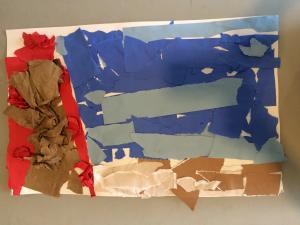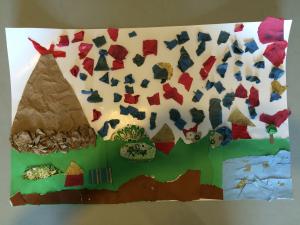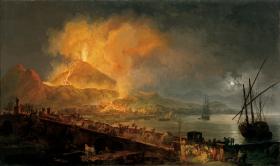Session 1 – Discuss/Write
Use the Think / Puzzle / Explore strategy to discuss the painting with the class and then have students write about the piece.
Ask:
What do you think you know about this artwork or topic?
What questions or puzzles do you have?
What does the artwork or topic make you want to explore?
*The teacher can choose to record student thoughts and questions on chart paper to help support students with their writing.
Write:
Students write in their notebooks, responding to the question, “What’s going on in this picture?” and writing two questions they would like to explore.
Session 2 – Research
Allow students to research their questions in pairs/small groups on Discovery Education or by using text resources. They should keep notes about what they learn.
*Possible extension using current news – Use the Newsela article from May 16, 2016 (or one that is more recent) titled “Small earthquakes tremble the ground below Mount St. Helens volcano” to practice reading informational text. Students could discuss what the scene depicted in the painting might look like in modern day should Mount St. Helens erupt again.
Session 3 – Discuss/Write
Discuss:
Students share what they learned with the class in a whole group discussion. The teacher can record facts on chart paper for student reference. Revisit the painting and discuss how the information they learned impacts their thoughts about the “what’s going on in this picture?” question.
Write:
Students write in their notebooks, responding again to the question, “What’s going on in this picture?”
Session 4 – Compare/Reflect
Ask students to look at their writing before and after their research, reflecting on the difference between the two pieces. Students can discuss their findings in small groups and then share out any big ah-ha’s with the class. They will then use their writing notebooks to complete a written reflection about the impact of the research on their writing.
Session 5 – Create (optional extension)
Students work in groups to create a poster-sized, modern day version of this piece.
Ask students to imagine what the scene would look if the volcano erupted today. They can begin by sketching their own idea and then talking with their group about what it might look like. Once all members come to agreement about their group design, they will decide how to best depict the scene using only paper.
Teacher will evaluate discussion using local rubrics for student participation, including following rules for discussion, building upon others’ ideas, and asking questions.
Teacher will evaluate student writing for the ability to clearly explain their thoughts about the painting, referring to specific details as needed.
Teacher will evaluate student questions for clarity.
Teacher will evaluate student’s ability to conduct research and appropriately answer their questions.
Teacher will evaluate student’s ability to compare their writing before and after conducting the research and to be reflective about how the research impacted their writing.
volcano
eruption
volcanic eruption
lava
magma
active
dormant
vent
ash
The Eruption of Mt. Vesuvius
Newsela article - https://newsela.com/articles/sthelens-earthquake/id/17498/
Discovery Education videos https://app.discoveryeducation.com
Suggested videos:
Earth Science: Volcanoes
Mount Vesuvius and Pompeii
For the optional art project –
paper – in various colors, patterns and weights
craft glue
Think / Puzzle / Explore http://pzartfulthinking.org/?page_id=2
https://newsela.com/
https://app.discoveryeducation.com
books about volcanoes, such as:
Volcanoes by Seymour Simon
Volcanoes! (National Geographic) by Anne Schreiber
Time For Kids: Volcanoes! (Time For Science Scoops) by Editors of Time For Kids
books about Mt. Vesuvius, such as:
Mt. Vesuvius and the Destruction of Pompeii, A.D. 79 (Natural Disasters) by Russell Roberts
Pompeii...Buried Alive! (Step into Reading) by Edith Kunhardt Davis
I Survived the Destruction of Pompeii, AD 79 by Lauren Tarshis






